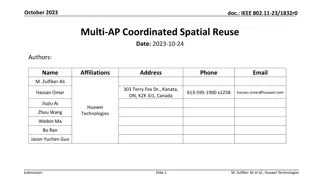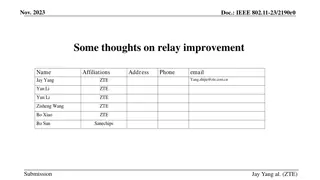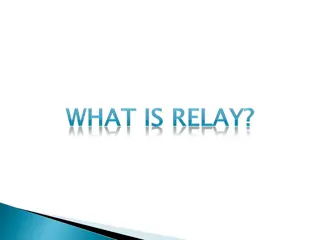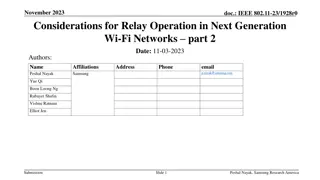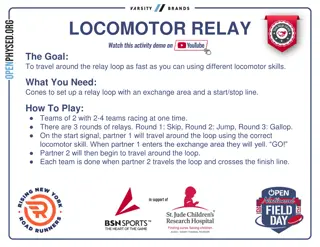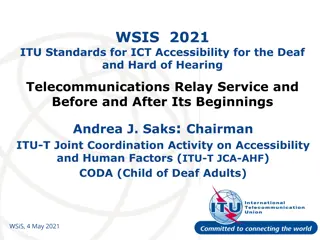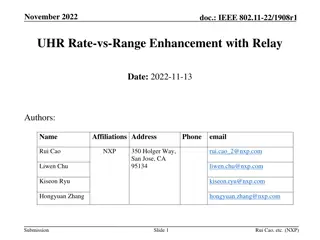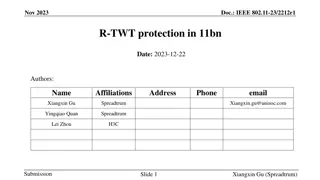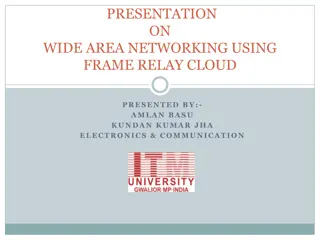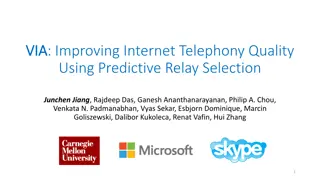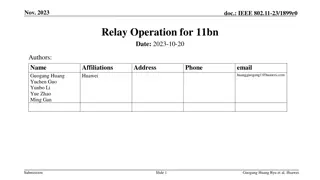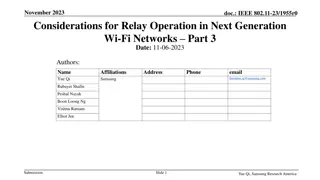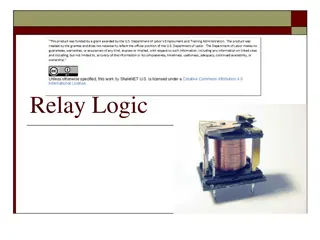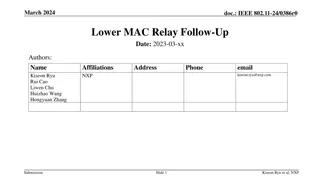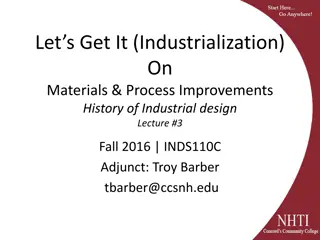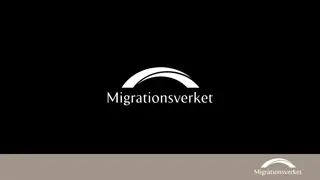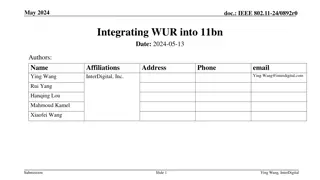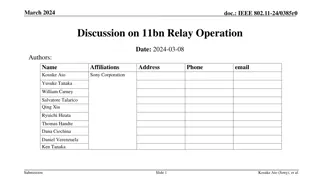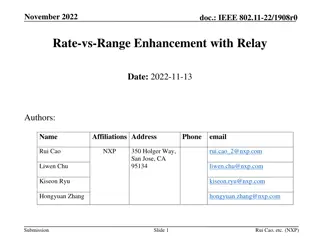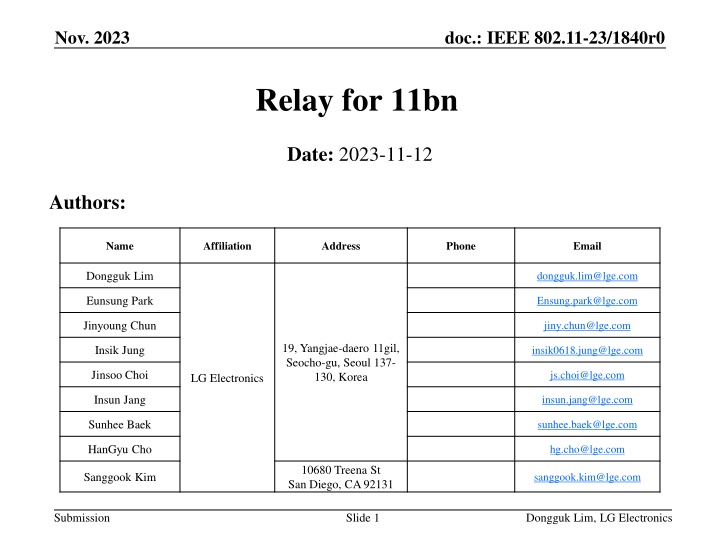
Improving Wireless Communication Through Relay Technology
Explore how relay technology enhances wireless communication by improving reliability, throughput, latency, and range extension in IEEE 802.11-23/1840r0. Learn about the benefits of single-hop relay, considerations for relay implementation, and the use of Relay Stations to optimize End-to-End Quality of Service (QoS).
Download Presentation

Please find below an Image/Link to download the presentation.
The content on the website is provided AS IS for your information and personal use only. It may not be sold, licensed, or shared on other websites without obtaining consent from the author. If you encounter any issues during the download, it is possible that the publisher has removed the file from their server.
You are allowed to download the files provided on this website for personal or commercial use, subject to the condition that they are used lawfully. All files are the property of their respective owners.
The content on the website is provided AS IS for your information and personal use only. It may not be sold, licensed, or shared on other websites without obtaining consent from the author.
E N D
Presentation Transcript
Nov. 2023 doc.: IEEE 802.11-23/1840r0 Relay for 11bn Date: 2023-11-12 Authors: Name Affiliation Address Phone Email Dongguk Lim dongguk.lim@lge.com Eunsung Park Ensung.park@lge.com Jinyoung Chun jiny.chun@lge.com 19, Yangjae-daero 11gil, Seocho-gu, Seoul 137- 130, Korea Insik Jung insik0618.jung@lge.com Jinsoo Choi js.choi@lge.com LG Electronics Insun Jang insun.jang@lge.com Sunhee Baek sunhee.baek@lge.com HanGyu Cho hg.cho@lge.com 10680 Treena St San Diego, CA 92131 Sanggook Kim sanggook.kim@lge.com Submission Slide 1 Dongguk Lim, LG Electronics
Nov. 2023 doc.: IEEE 802.11-23/1840r0 Introduction The main goal of UHR is to achieve Ultra High reliability, with respect to throughput, latency, packet loss, and power consumption, as described in the UHR proposed PAR document[1]. For the RvR (Rate-vs-Range) improvement, which is one of the main objectives of UHR, Relay has been introduced and discussed throughout various presentations[2~10]. In this document, we review the relay operation discussed in UHR SG and we propose to apply the relay in 11bn to achieve the improvement for purpose of RvR and range extension. Submission Slide 2 Dongguk Lim, LG Electronics
Nov. 2023 doc.: IEEE 802.11-23/1840r0 Relay communication Relay was addressed to achieve improved performance in the aspect of RvR and the range extension in [2,3]. Relay STA AP Destination STA (i.e. Non-AP STA) A Relay STA decodes the signal received from an AP and forwards it to an Destination STA(i.e. non-AP STA). Relay provides better link quality to both an AP and an Destination STA than a direct link between an AP and an Destination STA. Submission Slide 3 Dongguk Lim, LG Electronics
Nov. 2023 doc.: IEEE 802.11-23/1840r0 Considerations for Relay Relay STA Destination STA3 (i.e. Non-AP STA) Destination STA2 (i.e. Non-AP STA) AP Destination STA1 (i.e. Non-AP STA) In the relay topology, to provide the improved End-to-End QoS, the various consideration points in terms of RvR or Range extension should be taken into account. In the next slides, we take a close look at things that need to be considered in common or separately when relaying for RvR or Range extension. Submission Slide 4 Dongguk Lim, LG Electronics
Nov. 2023 doc.: IEEE 802.11-23/1840r0 Single-hop relay As described in [2], to reduce the complexity of relay protocol, we can consider relay communication with single- hop relay. With single-hop relay, the following gains can be considered. Simple and easy to manage. It does not require a complex routing algorithm like mesh networking. Low latency There are no additional delays due to multiple intermediate nodes. Less error accumulation It can prevent the error caused by the previous hop from causing more errors and accumulating with the hops. Relay STA AP Destination STA (i.e. Non-AP STA) Submission Slide 5 Dongguk Lim, LG Electronics
Nov. 2023 doc.: IEEE 802.11-23/1840r0 Relay transmission with a TXOP In Relay communication, the Relay STA transmits the signal to an Destination STA after receiving the data from the AP. To prevent the latency due to channel access of Relay STA for relay transmission and to perform the relay transmission efficiently, Relay transmission can be performed in one TXOP. To perform a relay transmission in a TXOP, as introduced in [2~7], Enhanced TXOP sharing can be considered. TXOP sharing for a relay is performed by the AP, and the Triggered TXOP sharing(TXS) defined in 11be or modified TXOP sharing method may be taken into account for relay communication. SIFS TXS TF AP CTS Relay STA In addition, Whether a TXOP for relay transmission will be shared with the Destination STA requires further investigation. Submission Slide 6 Dongguk Lim, LG Electronics
Nov. 2023 doc.: IEEE 802.11-23/1840r0 Channel information between Relay STA and an Destination STA To provide the improvement of end-to-end QoS, it needs to measure the channel information between Relay STA and Destination STA. To measure the channel information between a Relay STA and an Destination STA, the new channel sounding as described in [3, 4] can be considered. It is initiated by AP and as an initiation frame, a trigger frame can be considered. Here, a trigger frame may be designed newly because this frame is used to indicate the sounding information to STAs have the role of transmitter or receiver, respectively. Example of a sounding procedure for Relay STA and Destination STA [3,4] Triggering of channel estimation Report request SIFS AP Sounding PPDU SIFS Relay STA SIFS Feedback Non-AP STA(s) In addition, even in a relay transmission for range extension, a sounding procedure may be able to be performed to measure the channel between Relay STA and Destination STA to improve the end-to-end QoS. Submission Slide 7 Dongguk Lim, LG Electronics
Nov. 2023 doc.: IEEE 802.11-23/1840r0 Management frame relay The non-AP STA located out of AP s coverage can not receive the signal from the AP. Additionally, the signal from that STA can not reach AP. To achieve range extension for communication for the corresponding STA, the Relay STA can forward the received management/control frame from the AP to the corresponding STA. For example, the management frame such as beacon frame, probing frame, and association frame may be applied. Some capability information or elements may be added to the management frame. Regarding the forwarding or retransmission of the management frame through relay STA, we need further study. Management frame R_Management frame Relay STA Destination STA (i.e. Non-AP STA) AP Submission Slide 8 Dongguk Lim, LG Electronics
Nov. 2023 doc.: IEEE 802.11-23/1840r0 Discovery of Destination STA As in [3,4], to apply the relay efficiently in AP coverage, the appropriate non-AP STA should be detected before the relay communication. For that, the following can be considered. One thing is a discovery of non-AP STA existing near relay STA It can be initiated by AP or relay STA. and, to process it, a new frame exchange can be defined as described in [3]. Another thing is a check of Non-AP STA s signal reception status. It may be measured by AP or relay STA with conventional frame exchange. For example, non-AP STA for relay communication can be discovered with following procedure. Triggering frame Report Request SIFS AP Performing detection Relay STA SIFS Report Respond PPDU SIFS Non-AP STA(s) Also, since a non-AP STA may have mobility, it can be done periodically. Additionally, this procedure for discovering an appropriate Destination STA for efficient relay communication may be applied to relay transmission for Range extension. Submission Slide 9 Dongguk Lim, LG Electronics
Nov. 2023 doc.: IEEE 802.11-23/1840r0 Performance enhancement The relay communication provides the improvement of both throughput and latency. As described in [2], in an aspect of throughput, the transmission with a relay provided a 20% to 200% end-to-end throughput gain compared with direct transmission. In addition, the transmission with a relay provides a low latency for end-to-end transmission. As shown in [10], due to the better link quality of the relay link than a direct link, it is possible to use the high-order MCS for transmission. It causes the reduction of latency In channel conditions with obstacle/interference, we can get a gain of about 50%. Submission Slide 10 Dongguk Lim, LG Electronics
Nov. 2023 doc.: IEEE 802.11-23/1840r0 Summary To achieve improved reliability in terms of throughput, latency, and range extension, we propose to apply the relay communication in 11bn. In addition, for efficient relay transmission and to obtain the maximum gain, the following should be considered. Support of one-hop relay. Relay communication in a TXOP The channel sounding for between Relay STA and Destination STA The extended transmission of management/control frame Discovery of Destination STA Submission Slide 11 Dongguk Lim, LG Electronics
Nov. 2023 doc.: IEEE 802.11-23/1840r0 Straw poll 1 Do you support to apply the relay communication in 11bn to improve the reliability? The relay communication means source STA(ex., AP or non-AP STA) passes on the information to its Destination(ex., non-AP STA or AP) through the Relay STA. It may be optional feature in 11be. Yes No Abstain Y/N/A: Submission Slide 12 Dongguk Lim, LG Electronics
Nov. 2023 doc.: IEEE 802.11-23/1840r0 Straw poll 2 Do you agree to apply a single-hop relay transmission in 11bn? Yes No Abstain Y/N/A: Submission Slide 13 Dongguk Lim, LG Electronics
Nov. 2023 doc.: IEEE 802.11-23/1840r0 Straw poll 3 Do you agree to perform a channel sounding for Relay STA to Destination STA channel? The details for channel sounding for relay STA to Destination STA channel is TBD. Submission Slide 14 Dongguk Lim, LG Electronics
Nov. 2023 doc.: IEEE 802.11-23/1840r0 Reference [1] IEEE 802.11-23/0480r3 UHR proposed PAR [2] IEEE 802.11-23/1908r1 UHR rate-vs-range enhancement with relay [3] IEEE 802.11-23/0042r0 Thought for Range Extension in UHR [4] IEEE 802.11-23/1138r1 Features to consider for efficient Relay operation [5] IEEE 802.11-23/1139r0 Relay transmission in UHR [6] IEEE 802.11-23/1146r1 Relaying for Low Latency Traffic in UHR [7] IEEE 802.11-23/1175r0 UHR relay follow up [8] IEEE 802.11-23/1450r1 Consideration on UHR Relay Architecture [9] IEEE 802.11-23/1517r0 Follow up on the Relay Transmission [10] IEEE 802.11-23/1518r0 Evaluation for the Relay Transmission Submission Slide 15 Dongguk Lim, LG Electronics

